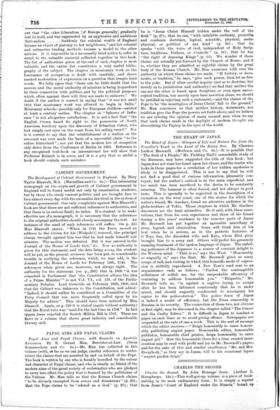CHARLES THE SECOND.
Charles the Second. By John Heneage Jesse. (Arthur L. Humphreys. 12s.)—This well-got-up volume is a piece of book- making in its most rudimentary form. It is simply a reprint from Jesse's " Court of England under the Stuarta" bound up with Cunningham's "Story of Nell Gwyn." The result is a read- able and entertaining'volume, and we should have no quarrel with the publisher if he had mentioned the fact in a preface or note. As he has not thought fit to do so, the .general reader for whom the book is intended might easily imagine that he had purchased an original study of the time, for the names of Jesse and Cunningham are probably not familiar to any but professed students. Jesse's account is a personal Life of the King, and was destined to " rescue from entire reprobation the name of the libertine Charles." The story of his escape after the battle of Worcester is given with much interesting detail, and also his adventures on the Continent (Lady Byron being mentioned as his "seventeenth mistress abroad"), his fruitless matrimonial pro- jects (Cromwell and Mazarin both "rejected him as a son-in-law"), his sojourns at Cologne and at Bruges, where his Court, which was often in want of the common necessaries of life, gave much occasion for scandal: The life and habits of Charles as King are better known, and the most valuable chapter on this peribd is the story of his death, and the discussion as to whether he was poisoned or not by the Roman Catholic party alarmed at the prospect that Charles was at last about to yield to the pressure of Parliament and agree to the exclusion of the Duke of York from the throne. The accepted theory is that he died of an apoplectic seizure, but the circumstances are far from clear; and many of the symptoms, as well as the strength of Charles's constitution and his moderation and constant care of his health, favour the supposition of poison. The Duchess of Portsmouth, " Madam Carewell," as the people called her, always maintained that he died of poison. The "Story of Nell Gwyn" is perhaps the better of the two portions of the book. If Cunningham is not always trust- worthy, he at least collected and preserved all there is to be known about his heroine; and much curious information about the stage at the Restoration, and of Nell's success as an actress, her love affairs, her faithfulness to Charles (her Charles III., as she said, the first being Charles Hart, the handsome actor, and the second Charles, Lord Buckhurst), her ready wit, and her abiding popularity with the lower orders. Two chapters on the character and witty sayings of " Old RoWley," culled from Clarendon, Halifax, Buckingham, Evelyn, Burnet, Dryden, and Roger North, are as good as possible, and show how his indolence, sensuality, and "unthinkingness" were redeemed by his good understanding, his love of poetry and .poets and of architecture, his interest in science, in mathe- matics, in shipping and seafaring. It is curious that so little remains recorded of the conversation of so brilliant and charming a raconteur as Charles undoubtedly was. His love of talking was his distinguishing characteristic, but much of his talk "hovered between profanity and indecency." His vices, it is to be noted, interfered but little with his personal popularity with the people. The same was probably true of George IV. ; but in both cases the interests of the Monarchy ultimately suffered greatly.























































 Previous page
Previous page